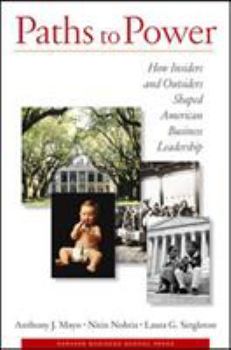Paths to Power: How Insiders and Outsiders Shaped American Business Leadership
Select Format
Select Condition 
Book Overview
'Paths to Power' sheds light into the changing demographic composition of American business leadership and reveals why these subtle changes are in fact quite groundbreaking. This description may be from another edition of this product.
Format:Hardcover
Language:English
ISBN:1422101983
ISBN13:9781422101988
Release Date:January 2007
Publisher:Harvard Business Review Press
Length:292 Pages
Weight:1.40 lbs.
Dimensions:1.2" x 6.5" x 9.2"
Customer Reviews
3 ratings
Something you must know while planning your career
Published by Thriftbooks.com User , 16 years ago
This book is extremely valuable for young people who want to succeed in business. There are several essential social and economic contexts what separated outsiders from insiders in America's business leadership in the 20th century and are continuing shape business leadership in the 21st century. These are also social and economic backgrounds impacting business leadership internationally though in different degrees. Look for them in the book and you will benefit a lot from understanding them. This book is especially helpful in planning a top-notch career.
How leaders in the 20th century reached the "apex"
Published by Thriftbooks.com User , 16 years ago
I recently read In Their Time, co-authored by Anthony Mayo and Nitin Nohria, in combination with this book whose subtitle correctly indicates what Mayo, Nohria, and Laura Singleton set out to explain: how "insiders" and "outsiders" of big business (as Michael Useem explains in an insightful Foreword) presided "over our dominant organizations" and, in process, examine "which pathways lead to the apex - or which do not" for those who would also achieve such dominance. Rather than limiting their attention to a set number of exemplary leaders - in chronological order -- and then devoting a separate chapter to each, taking a linear approach to the material, the co-authors chose to examine the evolution of 20th century business leadership in terms of the ten decades, assigning to each following the first chapter an appropriate component (birthplace, nationality, religion, education, class, gender and race, etc.) while frequently cross-referencing throughout the entire century. For example, they juxtapose comparable individuals such as James Stillman's presidency of National City Bank (1891-1909) and Sanford "Sandy" Weill's of Citigroup (that National City Bank eventually became) a century later. Mayo, Nohria, and Singleton's role In Paths to Power is more that of cultural anthropologists than as biographers or even business historians. They create a social and economic context within a 100-year framework as they examine what separated outsiders from insiders in business leadership in the 20th century. In the city where I live, we have a number of outdoor markets at which slices of fresh fruit are offered as samples of the produce available. In that same spirit, I frequently include brief excerpts from a book to help those who red my review to get a "taste." Here is a representative selection from the material that Mayo, Nohria, and Singleton provide. On birthplace: "As a starting point in our examination of twentieth-century leader backgrounds, we thus come away with the decisive conclusion that even in the United States, the great land of opportunity, not every birthplace was created equal...While mobility between regions tended to increase later in the century, people with more prosperous family origins - origins that typically stemmed from birth in a similarly prosperous region of the country -retained an advantage when entering business in a new area. The distinguishing features of each of the country's major regions, both as sources of and sites for leaders, will constitute an important backdrop for further discussions about leader characteristics." (Page 54) On education: "Yale's popularity among business leaders like the Weyerhaeusers vaulted it to a preeminent position in the early part of the century: it was the most popular school for all of our leaders prior to 1950, educating thirty-two of them (about 15 percent of all that era's college graduates). With twenty-seven leaders, Harvard came next, and Massachusetts Institute of Technol
Insightful
Published by Thriftbooks.com User , 17 years ago
An incredibly well written analysis of the people who have helped shaped America's business world through the last century. To gauge the future you must have an understanding of the past.




